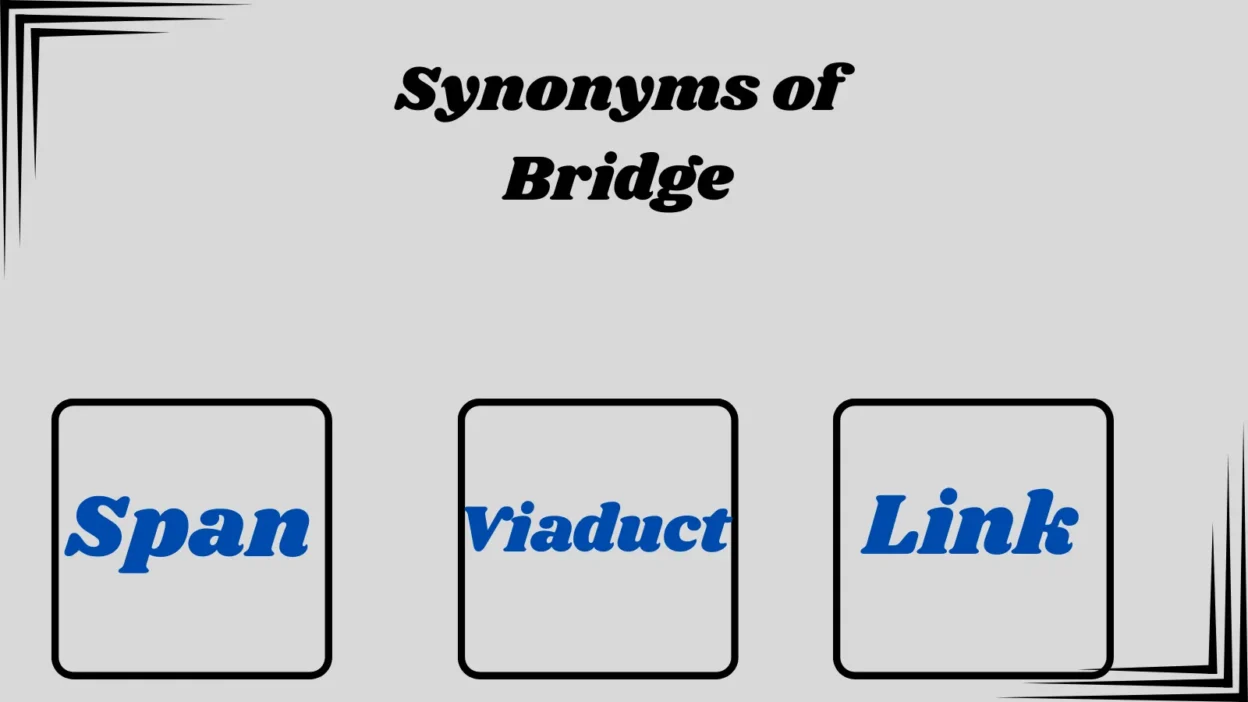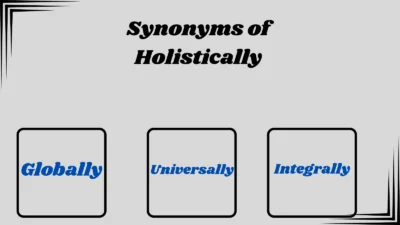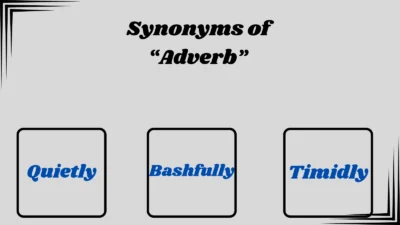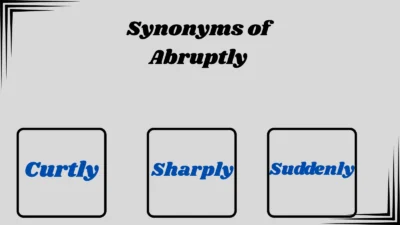Synonyms of bridge help describe structures or means that connect two points, such as span, overpass, or link. For example, the bridge over the river makes travel much easier. Using the right synonym lets you talk about physical structures or metaphorical connections with clarity and variety. Each word highlights different ways to connect places, ideas, or people.
If you’re writing about engineering, communication, or relationships, choosing precise synonyms for bridge helps you express connection and transition effectively.
In this article, you’ll get the meaning and example sentence for each synonym of bridge, so you can talk about bridges confidently. Ready to explore the many ways to say bridge?
What Does Bridge Mean? Key Nuances
A bridge is fundamentally about connection and transition. It often implies:
- Linking two separate points or groups
- Overcoming a gap, barrier, or difference
- Serving as a pathway or facilitator
- Symbolizing unity, cooperation, or reconciliation
Unlike words that describe division or separation, a bridge inherently suggests coming together. It’s neither aggressive nor passive but a constructive, sometimes modest connector — it’s not flashy, but it’s essential.
30 Synonyms of Bridge — When and How to Use Them
1. Link
A straightforward word meaning to connect two things directly.
Example: The new subway line links downtown with the airport.
Use it when referring to simple connections, especially in technology or communication.
2. Span
Emphasizes the distance covered by a bridge or connection.
Example: The old bridge spans the river.
Use it when focusing on length or breadth, often physical or metaphorical distance.
3. Overpass
A road or bridge built over another road or railway.
Example: Take the overpass to avoid the traffic jam below.
Use it when specifically talking about infrastructure in traffic or urban contexts.
4. Viaduct
A long bridge-like structure carrying a road or railway over a valley or other roads.
Example: The viaduct offers stunning views of the countryside.
Use it when describing long elevated bridges, often impressive or engineering marvels.
5. Causeway
A raised road or track across low or wet ground.
Example: The causeway connects the island to the mainland.
Use it when emphasizing a road built over marshy or waterlogged terrain.
6. Arch
A curved structure that supports a bridge or doorway.
Example: The ancient stone arch has stood for centuries.
Use it when referring to a specific architectural feature or symbolizing strength and elegance.
7. Footbridge
A bridge designed only for pedestrians.
Example: She crossed the footbridge to reach the park.
Use it when talking about pedestrian-only bridges, often intimate or small-scale.
8. Trestle
A framework of beams supporting a bridge or elevated track.
Example: The train passed over the wooden trestle.
Use it when describing specific structural elements, often rustic or historic.
9. Connector
Something that joins or links two parts.
Example: The new connector road will ease traffic congestion.
Use it when highlighting the function of linking rather than the form.
10. Passage
A route through or across something.
Example: The mountain passage was treacherous but necessary.
Use it when focusing on movement through a space, often metaphorical or physical.
11. Linkage
A chain or system of links connecting things.
Example: The linkage between diet and health is well documented.
Use it when emphasizing relationships or systems of connection.
12. Conduit
A channel for conveying water, electricity, or information.
Example: The conduit carries cables beneath the street.
Use it when referring to channels that transmit or carry something intangible or tangible.
13. Joint
A point where two parts are connected.
Example: The joint between the two beams was reinforced.
Use it when emphasizing the connection point rather than the connecting structure.
14. Spanway
A less common synonym for a bridge or crossing.
Example: The spanway was constructed to allow passage over the creek.
Use it when you want a poetic or slightly archaic term.
15. Overcrossing
A bridge that crosses over a road or railway.
Example: Use the overcrossing to avoid the busy intersection.
Use it when in a transportation or urban planning context.
16. Archway
An arched opening or passage.
Example: The garden archway welcomed visitors with blooming flowers.
Use it when focusing on entrances or symbolic gateways.
17. Pass
A gap or route through mountains or difficult terrain.
Example: The caravan made its way through the mountain pass.
Use it when talking about natural routes or difficult passages.
18. Footpath
A path for walking, sometimes elevated.
Example: The footpath leads to a scenic overlook.
Use it when referring to pedestrian ways, especially informal or natural ones.
19. Causeway
Raised road or track across wet ground or water.
Example: The ancient causeway linked the island villages.
Use it when stressing raised routes over difficult terrain.
20. Overbridge
A bridge that crosses over another road or railway.
Example: The new overbridge improves traffic flow considerably.
Use it when discussing infrastructure in urban transport.
21. Ramp
A sloped surface connecting different heights.
Example: The wheelchair ramp makes the building accessible.
Use it when emphasizing accessibility or elevation changes.
22. Viaduct
An elevated structure for carrying traffic over obstacles.
Example: The viaduct spans the valley below the city.
Use it when talking about engineering feats in large-scale bridges.
23. Link Bridge
A connecting bridge between buildings or terminals.
Example: The airport link bridge connects the terminals seamlessly.
Use it when referring to enclosed or functional connectors in buildings.
24. Skywalk
A pedestrian bridge often elevated between buildings.
Example: The skywalk keeps commuters safe from traffic below.
Use it when focusing on urban pedestrian pathways above ground level.
25. Connection
A broad term for linking or joining.
Example: There is a strong connection between the two departments.
Use it when referring to abstract or emotional links.
26. Transition
A process or period of changing from one state to another.
Example: The bridge acted as a transition between childhood and adulthood.
Use it when emphasizing change or movement between phases.
27. Linkup
An informal term for a connection or meeting.
Example: The linkup between the two companies was successful.
Use it when describing informal or collaborative connections.
28. Nexus
A central point linking multiple things.
Example: The city is the nexus of trade routes.
Use it when describing hubs or focal points of connection.
29. Bond
A connection that unites people or things emotionally or physically.
Example: The bridge created a bond between two communities.
Use it when emphasizing emotional or social ties.
30. Coupling
A mechanical or symbolic joining of two parts.
Example: The coupling of theory and practice improved the course.
Use it when focusing on joining components or ideas.
How to Choose the Right Synonym
- For physical structures: Use words like viaduct, overpass, causeway, or footbridge, depending on size, purpose, and location.
- For abstract or emotional connections: Choose bond, nexus, connection, or linkage to highlight relationships or unity.
- For transitional or process-focused contexts: Transition or passage emphasizes change and movement.
- For urban or traffic-related contexts, Overcrossing, skywalk, and link bridge fit best.
- For poetic or metaphorical tone, Words like archway, spanway, or nexus add elegance or emphasis.
Cultural context matters too. For example, nexus and bond might appear more in formal or literary English, while linkup is casual and conversational. Technical fields prefer precise terms like conduit or coupling.
Conclusion
In conclusion, exploring synonyms of bridge allows us to better capture both literal and metaphorical forms of connection. Whether you’re referring to a structure that spans space or a concept that unites people and ideas, these alternatives offer the flexibility to match your intent.
With options like link, span, and connector, your language can be as strong and purposeful as the bridges you’re describing.
Now that you’re equipped with these variations, choose the one that best fits your context, and build stronger communication one word at a time.



